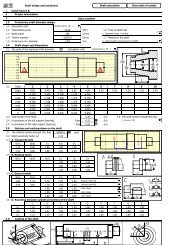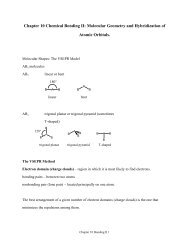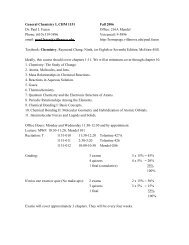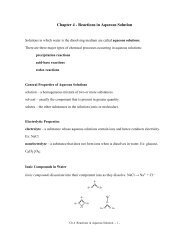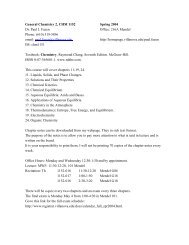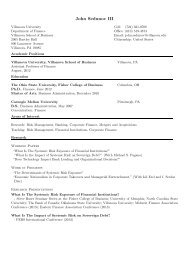A Culture of Collaborative Inquiry: Learning to Develop and Support ...
A Culture of Collaborative Inquiry: Learning to Develop and Support ...
A Culture of Collaborative Inquiry: Learning to Develop and Support ...
Create successful ePaper yourself
Turn your PDF publications into a flip-book with our unique Google optimized e-Paper software.
The decision <strong>of</strong> the SC <strong>to</strong> formally engage as a PLC was made inlate summer 2004, <strong>and</strong> the negotiation <strong>of</strong> an inquiry question thatdrove the direction <strong>of</strong> the SC‘s work during the targeted timeframeslowly emerged, eventually becoming, “How can we foster <strong>and</strong>sustain a culture <strong>of</strong> collaborative inquiry?‖ The inquiry questionwas aimed at addressing our own needs as an emergent group <strong>and</strong>support the primary pr<strong>of</strong>essional development goals <strong>of</strong> the project.At times, this question directed our focus <strong>to</strong>ward underst<strong>and</strong>ingwhat it was like <strong>to</strong> work as a critically oriented, questioning groupexamining our own practice <strong>and</strong> making meaning <strong>of</strong> the dialogue,<strong>to</strong>ols, <strong>and</strong> resources that we employed. At other times, thisquestion turned our focus <strong>to</strong> underst<strong>and</strong>ing <strong>and</strong> supporting theteachers‘ PLCs.DATA COLLECTION AND ANALYSISTraditional qualitative data sources were collected <strong>and</strong> analyzed inthe construction <strong>of</strong> the narrative, including interviews, archiveddocuments, <strong>and</strong> video <strong>and</strong> audio recordings <strong>of</strong> SC meetings.Interviews <strong>of</strong> each SC member (including authors Tamara, David,<strong>and</strong> Tom, <strong>and</strong> excepting Dar, who was not available) provided anessential data source that grounded our analysis. Because theauthors were so immersed in the group from the beginning, we feltthat our interpretation <strong>of</strong> the committee‘s evolution <strong>and</strong> actionsneeded triangulation. The interview questions emerged from atheoretical framework focused on the negotiation <strong>of</strong> differences inknowledge, beliefs, <strong>and</strong> expertise. This theory presents threestances that people coming <strong>to</strong>gether in a partnership might assume:a stance <strong>of</strong> inquiry <strong>and</strong> knowledge negotiation; a stance <strong>of</strong>consultation (i.e., as experts conveying information <strong>and</strong> knowledge<strong>to</strong> those less expert); or a stance <strong>of</strong> rejection, in which another‘sknowledge is seen as irrelevant or unfeasible <strong>and</strong> is discarded(Nelson, 2005). Knowledge negotiation is viewed as the stancemost likely <strong>to</strong> enable transformative, not just additive, growth. Theinterview questions afforded insight in<strong>to</strong> SC members‘ perceptionsabout communication, perceptions <strong>of</strong> pressures <strong>and</strong> risks in SCparticipation, group functioning, how people‘s roles within thegroup <strong>and</strong> positions outside the group impacted or influencedgroup processes, various aspects regarding the evolution <strong>of</strong> theproject <strong>and</strong> impact on teachers, <strong>and</strong> what each learned fromparticipation in this group.The interviews were conducted in Fall 2005 (excepting Julie‘s,conducted in early 2006) by Mart (a research assistant <strong>and</strong> the 3 rdauthor <strong>of</strong> this article) <strong>to</strong> better ensure each participant‘s comfort inresponding <strong>to</strong> the questions. Mart also conducted the initialanalysis <strong>of</strong> the interview transcripts, using a separate data table foreach question <strong>and</strong> identifying themes across each participant.These themes were further synthesized by the authors; majorthemes included the notion <strong>of</strong> a common vision for teaching <strong>and</strong>learning in mathematics <strong>and</strong> science as well as for pr<strong>of</strong>essionaldevelopment; the use <strong>of</strong> data <strong>to</strong> make decisions about pr<strong>of</strong>essionaldevelopment activities <strong>and</strong> facilitation moves; sharing leadershiproles in a PLC; how <strong>to</strong> work as a learning community; the role <strong>of</strong>content knowledge in the pr<strong>of</strong>essional development activities aswell as in the teachers‘ PLC work; <strong>and</strong> links between PRiSSM <strong>and</strong>other school <strong>and</strong> district initiatives.These themes were then also used as an analytic framework withother data. Documents provided a significant record <strong>of</strong> the SC‘sactivities, decisions, <strong>and</strong> processes, <strong>and</strong> also revealed the his<strong>to</strong>ry <strong>of</strong>the committee‘s decision <strong>to</strong> engage in our own collaborativeinquiry. Documents included meeting minutes taken by adesignated SC member <strong>and</strong> meeting notes taken by the first twoauthors. A variety <strong>of</strong> h<strong>and</strong>outs distributed during meetings werealso used, including case studies developed by facilita<strong>to</strong>rs, records<strong>of</strong> lead teacher PLC meetings, facilita<strong>to</strong>r‘s quarterly reports aboutteacher PLCs, pro<strong>to</strong>cols used for various purposes (such asstructuring dialogue around a piece <strong>of</strong> data), lists <strong>of</strong> collaborativenorms, <strong>and</strong> project goals. Various diagrams <strong>of</strong> conceptual8 | P a g e




